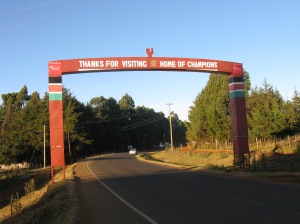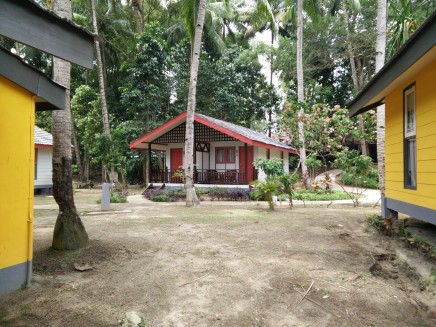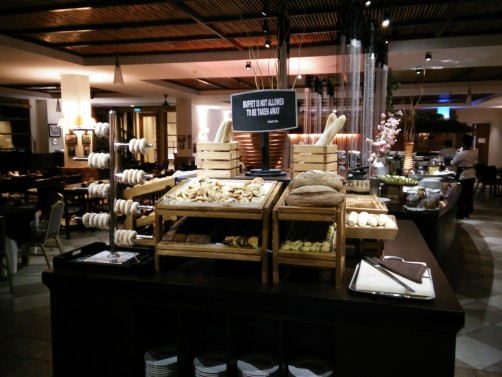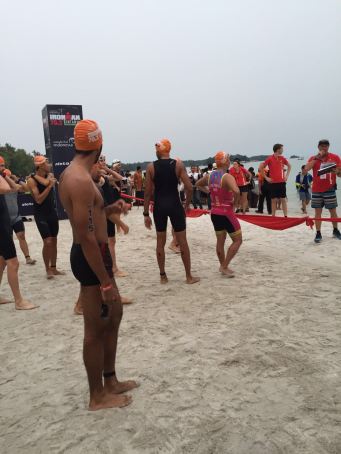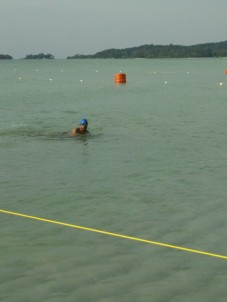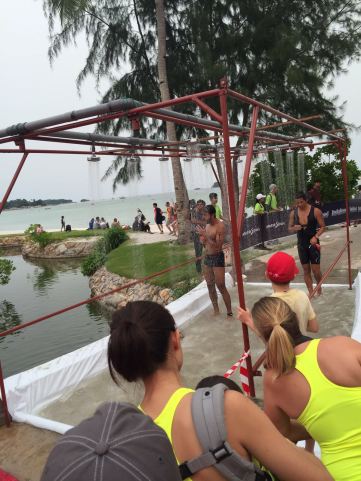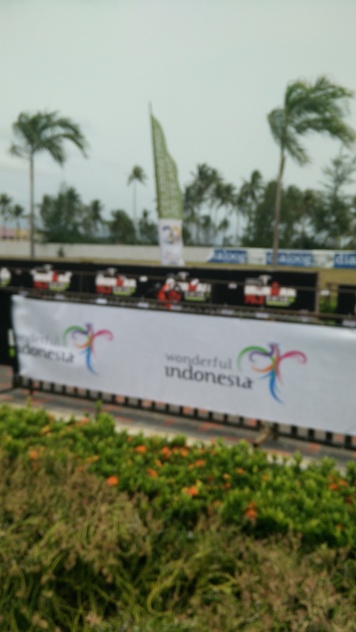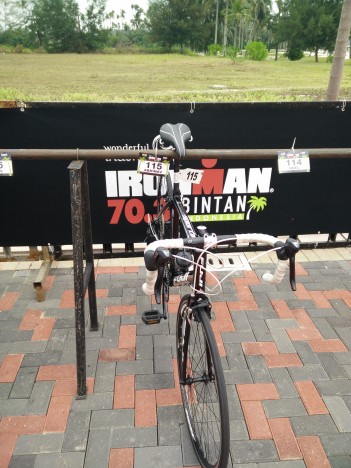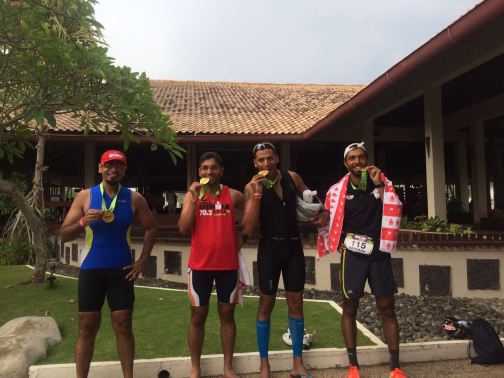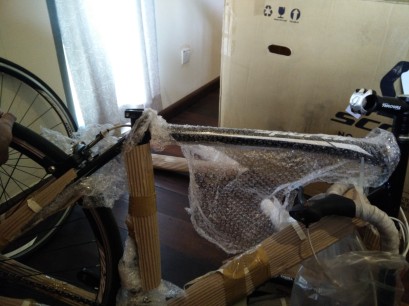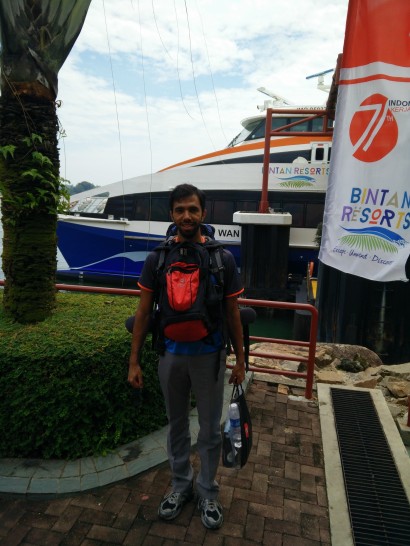My name is Abhinav, I am 22 years old, and I am a B.Tech biotechnology graduate and a running enthusiast. I am from Bangalore, India. On 21st July 2013, when I graduated with a B.Tech degree, and finished reading the book “Running with the Kenyans”, I started dreaming about what it would be like to run with the best endurance athletes in the world. I wanted a similar experience, to train and eat and live life like a professional Kenyan long distance athlete. On January 28th 2014, that dream was about to come true. I was at the airport, waiting to catch my flight to Kenya, and live an athletes life for two and a half weeks. I had booked a room at the High Altitude Training Centre (HATC) in Iten, Kenya. I have chronicled my experiences in this blog.
Day 1:
I reached Nairobi at 6 30 and got out of the airport at 7 30. As I went through customs, the immigration officer routinely asked me, ‘why do you want to to come to Kenya? And where do you want to go?’, to which I told him that I want to train at the HATC. He looked at me blankly, then said ‘But you are Indian. I have never seen an Indian run’, followed by ‘ you can train with the kenyans, but you will never beat them, here is a visa for three months. Now go and train.’
I was picked up from the airport by my friend, Mrs.Geeta. Nairobi is quite a crowded city, with traffic building up even at 8 in the morning. It took me 2 hours to reach the centre of the city. I reached her house at 10. Her house was near the Westgate mall, where a recent terror attack occurred. I ate some delicious Indian food, with Adai and Chutney for breakfast. I was quite sleepy and tired after the travel, so I slept for 2 hours. Then I ate rice, beans curry, carrot and cabbage curry, dal, a dish like rajma, and one mango. It felt like I was carbo loading for the runs that I will do at Iten. I left their house at three and reached the airport at four thirty, just in time for my flight.
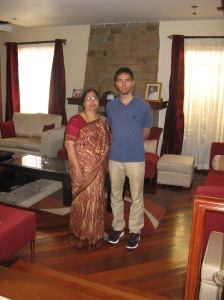
Traffic in Nairobi is just like Bangalore traffic but there is no public transport here. Only small minivans are there, but no large buses. Traffic is mainly due to the cars.
After getting dropped at the Nairobi airport, I took the flight to Eldoret. The flight was delayed by half an hour. I slept through the flight, and when I reached, I was met by Daniel, and he drove me to the HATC. The drive was about an hour and a half long. The drive from the airport to the Eldoret town was through beautiful green countryside. The airport itself was quite scenic, and the countryside was beautiful, not similar to how Adharanand described it. I felt it had a bucolic charm to it.
The Eldoret town was just like any semi urban town in India, but with butcher shops selling beef instead of mutton like India. After we crossed Eldoret, we drove through long stretches of land with few settlements on either side. The drive was quite beautiful, with rolling hills on both sides and lush green trees.
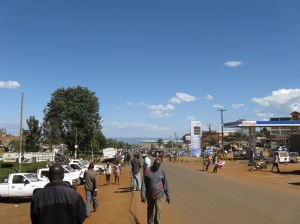
We went through a small alleyway along the side of the road and drove into the HATC. Here I met Songok, a tall lanky man with a casual demeanor. He was the manager of the HATC. He took me to the cafeteria, where I met the chef, Willy. He, like all the others, found my name difficult to pronounce. I ate my first authentic kenyan meal here, ugali with boiled spinach and chapati. The ugali was like a tasteless idli, and the chapati was quite sweet. After the meal, Songok gave me a short tour of the place.
During the tour, i saw Mo Farah in a room with the British athletes. The place looks very cosy, with a swimming pool, a well equipped gym, and a lounge with a lot of sofas for the athletes to relax. Songok tells me that the wifi is very slow when there are a lot of people. He also tells me that the coaches like it, because they want the athletes to rest and sleep when they are not running.
Day 2:
Today was to be my first run in Kenya, and my first run with the Kenyans. This may be obvious, but there a lot of whites who are running here in large groups. The HATC camp has only whites, the majority of them from England. Most of them seem like professionals. I struggled to get up, but finally awoke at six. I had already changed into my running clothes at night. I put on my socks and shoes, and stepped outside. It was quite chill, so I wore a jacket, locked my door and headed out.
I didn’t know what to expect. I was walking along the short dirt path, which leads to the main asphalt road. Next to this road is a mud track for runners. I walked along the road for a while, crossed it and soon found a Kenyan going at a pace with which I could keep up. He was running alone. He was around six feet, slim and looked very fit. I didn’t think he would be a marathon runner, as he had too much muscle for that. I nervously asked him as he was passing by if I could join him. He agreed, and I was off! We continued at a gentle pace, around 5 and a half minutes per kilometer. The first 0.7 km was a steep downhill, so that wasn’t tough. I remembered what Songok told me the day before, he told me to take it easy as it would take me some time to acclimatize to the 2400m elevation.
Up ahead on the road, we took a left and continued for around seven minutes. Down this road we saw a couple of amateurs running with a Kenyan who was also coaching them. This route was also a downhill slope, so I was worried about the uphill’s that would come next.
I asked the Kenyan his name. He said it was Sammy. He asked me mine, and just like anyone else he couldn’t pronounce it. So I told all of them to just call me Abhi. He asked me how much I run, and I told him – half marathon. He showed a bit of surprise and asked 60 minutes? I said 90. And the surprised expression was wiped from his face. He said he runs 10k. I asked him 35? And he said 29. Now it was my turn to be surprised. We turned another left and this is where the uphill’s started. I didn’t find it too tough because the distance was less and so was the speed. We took another left and ended up where we started. I thanked my running buddy and he continued on.
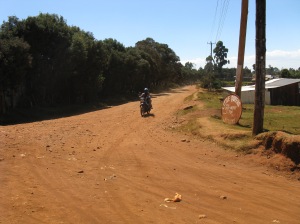
Then, as I was walking back to the HATC, i met a runner called Eva. She was short, slightly bulky, and was very friendly. We introduced each other, and she told me to come and stretch along the side of the road. We got chatting, and she told me of how she dropped out of college as she didn’t do well, and took up athletics as a full time profession. She was similar to the characters in Finn’s book, who only run for a living and hope that someday someone recognizes them, or that they become good enough to race abroad and win some money.
When I told her that I stayed in the Adidas camp, she said her house was also close by. She took me to her house and showed me around. There I saw other runners similar to her; all waiting for that golden ticket.
I went to the HATC and had some breakfast- bread, fried eggs, butter and jam, some juice, and chai. I went back to the room and slept for an hour and a half. Then I got up, and came over to the HATC. I decided to go to the gym, and did some stretching for half an hour. Then I went for lunch- carrots and dry grapes and pineapple salad, bread, and peanut soup. There was only some beef rice, so the chef brought me some rice without the beef. I had told him the previous day that I was vegetarian. A tall, slim, and David Rudisha lookalike came and sat next to me. He said his name was timothy, and that he runs 800m in 1:46.
After lunch, I decided to nap for a while, but ended up sleeping for two and a half hours. I woke up, put on my shoes and decided to go for my evening run. I stepped out, and waited for people to come along. The problem was that all of them were clipping! So I had to wait for a slightly slower Kenyan, who didn’t arrive. Then I saw some Brits preparing to run with Mo Farah. I thought of asking them if I could join, but I chickened out. I found an older man and young woman running, and decided to join them. After about ten minutes, they were finished, so I continued on my own. I ran for a total of around twenty five minutes, and decided to stop, and push it tomorrow at 9 15 when the hundreds of Kenyan professionals go for a run.
I went back to my room, took my change of clothes, and walked toward the HATC to hit the sauna. On my way, I saw Mo Farah laughing and chatting with some Kenyans. When he was finished I walked up to him and told him that I am from India and a big fan. He asked me my name and the distance that I run. I asked him if he had any tips for us amateurs, and he said ‘just enjoy it, and slowly build up’: pretty good advice. Another thing that stuck me after I finished my sauna and shower, was that I was the only one around here who had hair on the legs. Everyone else either didn’t have hair or had shaved it off!
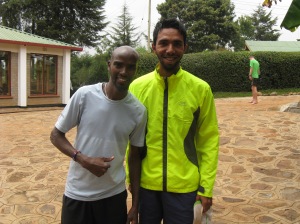
While I was walking over for dinner, I met this guy from England called john. He said he had come to India previously, where he ran the 10k in 28 1/2 minutes at the commonwealth games.
Today’s dinner was quite nice. I had ugali with cabbage, carrot and beans stew, and a very tasty pizza made from homemade bread and cooked in a wooden fire oven. After that I relaxed for a while at the lounge, and read guns, germs and steel.
Day 3:
As usual, I struggled to wake up today. I went for a run at 6 30 and waited for some runners to arrive. There were quite a few, but all of them were quite fast. I saw a couple of slower runners, so I tried to follow them, but they soon picked up pace. I ran a different route today, one with more ups and downs. I ran for about 25 minutes and stopped. I went in for breakfast- fried egg, bread, oats, and chai. I went back to the room to nap for a while, but as usual ended up sleeping for an hour and a half. I didn’t sleep well at night as the power had gone out, and as I had slept heavily in the afternoon.
I awoke at around 10, and decided to go for a short run. It wasn’t as chill as it was in the morning, so I left my jacket behind. I started a slow jog down the road, when I saw two runners waiting to start. I greeted them and asked them if I could join. They were James and Ken. They happily agreed and we were off. I think many of these runners get bored of the monotony of running with the same partners; an additional runner is always welcome. I told them to go ahead, as I did not want to disturb their schedule. They said today was anyway their easy run, as they had run hard the previous day. We took a diversion from the main road and headed right toward the villages. The surroundings were beautiful. Bucolic is a better term. We ran along a dirt track, and on either side of us were small farms. It was situated on rolling hills, lush green, and with small children saying ‘how are you’ every now and then. They asked me if there were races in India, and about the prize money in the smaller races. I told them that the prize money was not much, but there were many races. I told them to continue and that I would turn back. They asked me if I would like to run for an hour. James was tall and slim, while ken was short and well built. I said okay, and they signed for me to follow. Till about 40 minutes the run was beautiful. Imagine a run through the rural fields and villages of India. It was exactly like that, but tougher as the track had quite a few stones, and was constantly going up and down. After 40 minutes, we reached the main road, crossed it, and continued down a steep downhill path. After this stretch came the hardest part of the run. We ran along a 45 degree steep slope for about five minutes. I wanted to give up and tell them to continue. I was gasping for air. But after that, we came back to the main road, and landed in front of the HATC. I said goodbye, and told them that I would see them at the same starting point at 10am on Monday. They agreed and we parted ways.
I went back to the HATC, did some stretching in the gym, and went for a shower, but there was no water. So I headed over to the cafeteria, where I had a heavy meal- a double egg omlette, spagetti with veges, carrot soup, and two slices of pizza.
After lunch, I took a bath and just relaxed by the poolside. I tried to sleep, but struggled to, although I was quite tired. I decided to go back to my room at the adidas camp and read my book there. I read a couple of pages, and was fast asleep. I slept for around an hour, woke up, and decided to walk over to a restaurant called Kerio view. It was around 1 km down the mud road. The restaurant and hotel is situated at the edge of a cliff, from where you can see a huge valley, of mainly uninhabited forests: the Rift Valley.
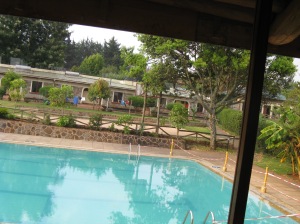
Day 4:
I got up at 6 30 and went out for a run. I was expecting lots of runners around, as today was supposed to be the long run day. But there was hardly anybody around. I saw a couple of runners across the road running at an easy pace, so I decided to join them. They were Joshua and Ouin.
We ran at a nice comfortable pace for 50 minutes. When I asked them why not a longer run, they said that tomorrow is the ‘discovery’ race at Eldoret, and that they were preparing for it. Joshua is a 64 minute half marathon runner.
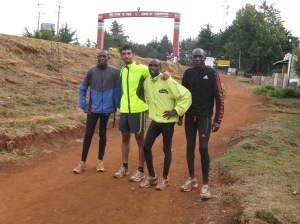
After the run I had some breakfast- eggs, oats, bread. After that I learned that the opening of the running track of the ‘Lornah Kiplagat sports academy’ was today, and that there was to be a kid’s race of 3 km from the HATC to the track as an inauguration.
I got my camera ready and waited to film the race. Once the whistle blew, the kids just sped past! It was fantastic to watch. After that i walked over to the track to see festivities. It is apparently the only track of its kind in Kenya. Once I got to the track, all the kids were seated under tents, and there were traditional singing, dancing, and generally a lot of fun things going on. Mo Farah and Paula Radcliffe were also there, but they were surrounded by the press and other dignitaries.

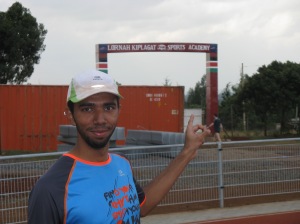
After the function I came back to have lunch-rice, boiled veges, I had a bath and decided to go into Iten town.
As I walked into town, I met Ouin again. He told me that he would take me to the track for a speed workout on Tuesday. Iten town is about two km from the HATC. Kenyans have an odd sense of time and distance. Even when I asked the guard Sammy directions to the new track, he pointed in one direction and said ‘right there’ while it was actually 3 km away! The same happened when I asked for directions to the town.
Iten is like any small town in India. It has small shops selling miscellaneous items and a huge market place. Since today was market day, there was a huge area in the middle of town with people selling clothes, shoes, and other miscellany.
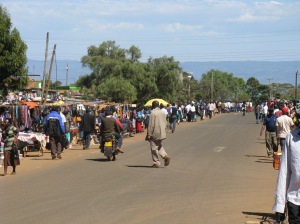
After browsing through the shops, I went over to kerio view, around a km away from my camp, to watch the paragliders. There I met Adam, a paraglider who stays in my camp. He showed me a good place for massages, and told me that a paraglider died a couple of days ago near here.
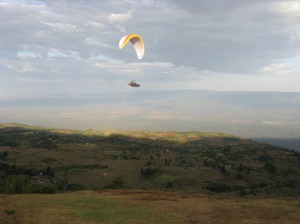
I came back to the HATC, and went to the gym for half an hour. After that, I watched some football and went to bed.
Day 5:
I woke up at 6 30 hoping to do a longish run. It was to be the fastest run that I would do in Kenya. I joined a boy and a girl, who were going quite slowly. But gradually they upped the tempo, and I soon found it very hard to keep up. I was gasping for air, and running at around 4:30min/km. After 40 minutes I slowed down and fell behind.
After that tough run, I had the usual breakfast, changed clothes, and took a very crowded matatu (minivan) into Eldoret. I tried to catch some sleep during the journey, as I had not slept well at night.
After reaching Eldoret, I walked about a kilometre down the road, to see that the women’s race was going on. It was a 10km race, and seeing them run was really entertaining.
Once the women’s race was over, I hung around waiting for the men’s race to start. After about half an hour, there were 584 athletes ready to start. Once the whistle was blown, it was utter chaos. It was like watching wilde beast being chased by lions. All the athletes were storming toward the front, and a couple of them fell down and had to bow out of the race. They were going at over 3min/km, with spectators lining the whole route and cheering on the athletes. It was a 3 km loop, which was to be done 7 times.
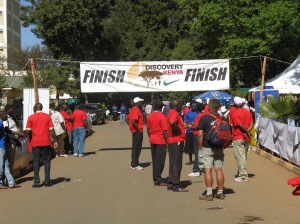
After the first loop, there was a semblance of a lead pack. It is a sight that every runner has to see at least once in their life. 584 athletes, with around 200 all within seconds of each other in the race and in terms of PB’s. The sweat dripping from their foreheads, the constant movement of the hands and piston like movement of the legs, the expression of focus and raw intensity on their faces; it really is a sight you can’t see anywhere else in the world.
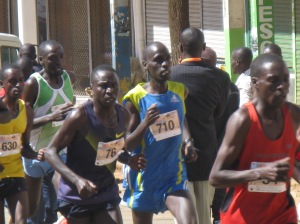
You can see from their faces that they take it very seriously. A win here could mean recognition which could mean a lot of money. The race itself was badly organised, with spectators constantly walking across the route, and a very badly designed route, with a couple of bottlenecks where a maximum of 6 runners could fit through.
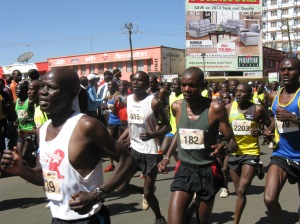
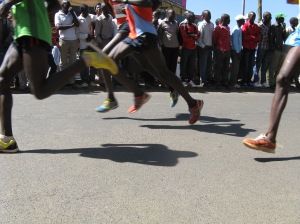
The winning time was 62:49. After the race, i ate a burger at a restaurant in Zion mall and took the matatu (minivan) back home. I slept till around 4 30, drank chai with bread and peanut butter, and went for a short run. I came back, changed, and ate dinner-ugali, spinach, omlette. I watched some football and relaxed in the lounge. As I was reading, Paula Radcliffe casually walks in and starts browsing the internet on her laptop. The world record holder in the womens marathon and the lady with 4 out of the five fastest marathon times in history is sitting a few feet away, and nobody really seems to care!
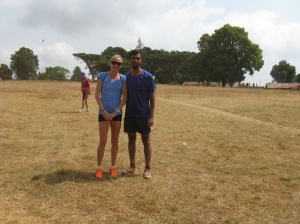
Day 6:
Today was to be an easy run with James and Ken at 10. I ate breakfast at 8 and hung around in the lounge. At 9 45 I went over to our meeting place, did a short warm up and waited for them to arrive. Since they were running a bit late, I found two guys getting ready for a run. I decided to join them, and soon two more guys and a girl joined. It was an easy 45 min run.
I have noticed that most Kenyan runners start of their runs at an easy jog, which acts like a warm up. Before their runs, they do some hamstring and quad stretches. As the run progresses, they gradually increase speed, till around 4 30 min/km at the end of the run.
Just after the run, one of them, Ezekiel, points to the woman and says that she runs a 66 min half. They ask me to join them again for the same run which they do at 10 everyday. This is supposed to be a recovery run. They ran 20 km this morning. I think if any of them are given two years of structured training, they can become world class runners. After the run I hung around in the lounge, when Mo Farah walks in with his laptop. Right now, this small town of Iten houses the world marathon record holder in men’s and women’s categories, the world 5000 and 10000 m champion, and other world class runners. I am in the midst of greatness, a heaven for runners.
I had a heavy lunch- spaghetti, green gram dhal, veges. I tried to get some sleep back in my room, but couldn’t so I headed into town. I looked around the small shops selling clothes, confectionaries, and other things, but wasn’t interested in any of it. The shopkeepers are quite friendly, always smiling, and when they looked at me, they gave a big wave. I came back to the room, and headed out for an easy run. I found a couple of polish guys- Mike and Chris, from the camp also going for a run, so I decided to join them. There are around 14 people from Poland, and many of them are amateurs. After an easy jog for around half an hour, we came back to the HATC to do some core drills. There is a class taken by the coach here, and he teaches everyone core stability exercises. Since this is designed for professionals, it was a killer for me. Monica Kiplagat was also taking the class, so it was no walk in the park.
After the class, i hung around in the lounge and went for dinner at 7. All the tables were full, except one that was totally empty. I sat down there, and an Australian athlete Dane, a 2:30 marathoner, joins me. After around 5 minutes, this other guy joins in. He is well built, with a round head, and closely set eyes.
He doesn’t speak English very well, but the three of us get chatting. I learn his name was Taoufik, and that he is from Algeria. He looks at my omelette, and I tell him that i don’t eat meat. He is very puzzled at this. He asks me chicken? Fish? He couldn’t quite understand the concept of a vegetarian runner. He says’ my brother, – points to his legs and goes- poof!’. He asks me if I am a champion from India, i tell him that I am just a recreational runner and he says ‘ oh that’s good’. Then the conversation moves on to the large population of India, how they play cricket very well. He says that football is very popular in Algeria, and that many sports are popular in Australia.
The Australian, Dane, is curious about his training, so asks him about it. He says that it is going ok today, and that he has three people coaching him now. He says there has to be a strong bond between coach and pupil, and that the coach has to inculcate confidence in the pupil. He says athletics is all in the mind, and that once you set your mind to something, you just blindly work towards it until you achieve it. He has 5 sisters and 1 brother. He told his sister when he was watching the Beijing Olympics that ‘ inshallah, next year i will be at the world championships in Berlin’. And he was there next year. From this line of conversation I figured he must be a very good athlete. He gets curious about India, especially how they worship cows and elephants.
We chatted for an hour and a half, until we were the only people left in the dining hall. Before leaving, we said goodnight, and out of curiosity, I ask him his full name. He shows me his facebook profile. It is Taoufik Makhloufi. The 1500m gold medallist in the London Olympics! I just had a candid one and a half hour conversation with the most famous man in Algeria, and an Olympic gold medallist! For all his fame and fortune, he seemed very humble and down to earth. It is a conversation that I will remember for a long time.
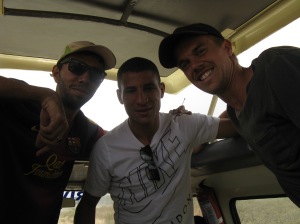
Day 7:
I finally gave up trying to get up at 6 and woke at 7 30 instead. I ate the usual breakfast, and waited for my first track session.
Me and the polish group of 14 set off on an easy jog to the track. The gate to the track is quite short, and you have to bend over and go through. One of the guys ran in and hit his head, resulting in a big cut on top of his head. His track session was ruined.
As I entered the track, I saw two large groups of around 20 Kenyans racing around. They were huddled so tightly that even a single misstep would have led to all falling down. But that was never going to happen. We did some stretches, and the polish coach came over and told me the program- 2*1km, 4*400m, 4*200m. I was running with Mike. I did an easy run yesterday with him so I knew who he was. The session went off very well. We also saw Mo Farah killing a couple of 400m in less than a minute with his training partners.
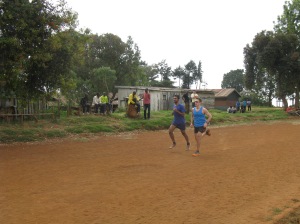
Once the session was over, we headed back to the camp, did some stretching and went in for lunch- pizza, carrot soup, rice and veges. The polish coach, Chris, sat down next to me, and so did Taoufik. Taoufik and Chris got chatting, and the conversation went like this:
C- what are you training for?
T- 1500m
C- oh ok. What is your best time?
T- 3:30.
C- Oh! Have you won any medals?
T- Yes, I am Olympic champion.
C- ‘ Thinking he is joking’, you mean European championship?
T- No, London 2012 Olympic gold medallist.
C- *confused look*
C- oh you are Taoufik Makhloufi! Wow!!* bumps fists*.
After chatting with Taoufik a bit more, I talked to Dane about going to the waterfall. Me, Dane, and a big Canadian called john- 2:20 marathoner- head out into the trail.
It was the usual mud trails for a while, but then we took a small turn into the grass, and slowly large trees were visible, before you know it, we were in the forest. We had to trek down a steep incline, through bushes, thorns, fallen branches; after which we reached the waterfall. Dane went in for a swim, while we just admitted the view- middle of a Kenyan forest, beautiful trees and sunlight peeping through the leaves, a couple of black and white monkeys. After his swim, we headed back to the camp.
I was quite tired, hence decided to skip the cool down run, and instead browsed around a shop called runners point. I thought I might get some running gear cheaper here, but it was not to be.
I had dinner, watched ‘American hustle’ on my phone for a while and went to sleep.
Day 8:
I went for my usual run at 10 with the Kenyans. It was a tough run, and we covered 8 km in 40 min. After that I stretched a bit and relaxed in the lounge. I ate lunch- pasta, rajma, veges. I took a nap till three as I was quite tired. I woke at 4 and went for an easy 6 k with the polish. After that was the killer core workout session with Richard, the coach in HATC. Then I went back to my room, and called a guy nearby who massages the athletes. I bought the local oil, which the athletes use for massage.
After he started the massage, I asked him if he was a professional athlete. He said yes; he was a 2:09 marathoner, and winner of the Milan marathon. He was faster than all the muzungus( Kenyan word for whites) in our camp. And he was giving me a massage!
After the relaxing massage, I had the worst time possible. I was in my room, almost naked, covered in oil, when the lights went off. It was pitch dark, I couldn’t find my clothes, and I had to take a bath in the dark. I somehow managed to do it, and headed out to dinner, only to find that dinner was over. I asked the chef for some food, and she gave me- ugali, cabbage, chapatti.
After dinner I spent some time in the lounge and went to sleep.
Day 9:
I thought of going to see the Kenyans do their fartlek, but I was too late and the motorcyclist took me the wrong way. Then, for some reason, he asked me to drive the motorcycle. I drove back to my room, quickly changed and went for a run. I went with the usual guys, but this time through a different route. The first 3k was easy, but then the leader of the pack picked up the pace to over 4min/km. I kept up for around two km, and then slowed down.
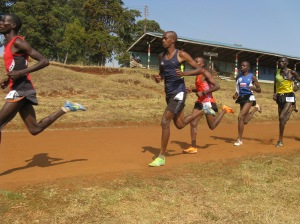
After the run, I went back to the lounge, relaxed for a while, confirmed my safari trip on Saturday with the Poles. I had lunch- brown rice, peanut soup and veggies.
After lunch, I decided to go out into Eldoret, just to pass the time. I took a overcrowded matatu (minivan) into town, and did some window shopping. Surprisingly, I couldn’t find any really good shops where you could get running shoes. I tried a couple of places, but they weren’t great. I went to a chemist, and bought iron supplements. The most common shops that you will find in Eldoret are chemist shops and banks.
I took a matatu back to the HATC, quickly changed, and went for an easy run. After the run, I relaxed in the lounge for a while, had dinner- pizza, ugali, veges, and went to bed.
Day 10:
I have skipped the report for day 10 because there wasn’t anything out of the ordinary that happened. I went for a run at 10, lunch, run again at 4, relaxed for a while, early dinner, and went to sleep.
Day 11:
I had to get up really early today because we were going on a safari. I got up at 4, and was ready to leave at 4 30. I was going with the Polish gang. We were 15 in total. One van arrived, which carried 8 people, and the other didn’t. He said that there was some communication error, and that there isn’t another one coming. People told me that this was typical of Africa, where things happen slowly and with a lot of delays. Songok organised the company van to take us, and we were off. Taoufik also decided to join us. It was a four hour drive to Nakuru, where we were going to the lake Nakuru national park.
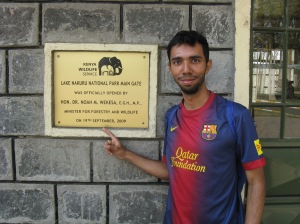
We reached at 9, and had some coffee. This was when one of the guys decided to play the 1500m finals on his ipad. We took a video of Taoufik describing the race, as it was running on the ipad. Going on a wildlife safari with an Olympic gold medallist happens only in Kenya. After the coffee, we went back to the car, got the permits, and set off for the safari. We saw some monkeys, water buffalos, giraffes, rhinos, and zebras. We were quite disappointed because we didn’t see any carnivores. We saw a glimpse of a lion before it disappeared. Taoufik kept calling me and Dane ‘India’ and ‘Australia’ as he couldn’t remember our names, or probably didn’t bother to, or anybody’s on the trip for that matter.
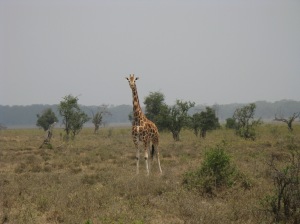
After the safari, I had the tastiest and the most expensive meal I have had in Kenya- bean and cheese burrito, french fries and mango juice. After lunch, we had a long journey back. Taoufik entertained many of us with his stories of how he came to Iten in 2012 without any accommodation, and had to stay in a hut for two weeks. He told us why he changed coach in 2012, and points to his head and says ‘athletics is mainly here’. He talked about the controversy of the 800m race in the Olympics. He said that he felt some pain in his knee once he started, and didn’t want to risk it .
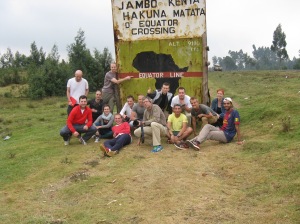
After more of general chatter in the van, we reached the HATC at 9pm. We had dinner-ugali, spinach, and cake for dessert, and went to bed.
Day 12:
Today was to be a long run day. I was still quite tired after the safari, so i woke up only at 7 40. I quickly changed, and headed over to the breakfast hall for a quick snack before the run, but it turned out that the long run with the polish was delayed by half an hour. After a good breakfast, I met them at the start point. They were doing a 30km run, but I decided to go only for 24.
I dropped my water bottle and a chocolate bar with the coach and we were off. We were doing an 8km loop. The toughest part of the loop was after around 4 km, where we hit a steep incline for around 800m. Everybody runs easy until this point, when we start breathing heavily and slow down almost to a walk. After three loops, i stopped and said goodbye. I was extremely tired, as I had not done this distance in over six months.
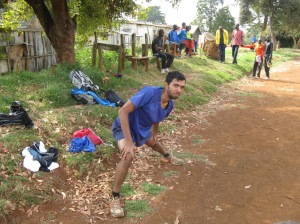
I stretched a bit and chatted with Pieter- Lornahs husband-for a while. After that I had a heavy lunch and slept for two hours. I woke at 4, hoping to go to the gym, but was still quite tired so I decided against it. After having some tea, I went over to Alberts- the masseuse and winner of the Milan marathon- as he told me that he could get me good and cheap racing shoes. There i again had some tea, and chatted with his brother for a while. I took a small video of him describing his training regimen and diet.
After that Albert took me to the place where I could get the racing shoes. They looked really good, and belonged to a marathoner. I bought them and came back to the room. I washed some clothes, and then went for dinner at 7 30. During dinner, two polish guys, Wojech and Michel, came over and invited me to a party. It was their birthday and they were celebrating it in the Iten club next door.
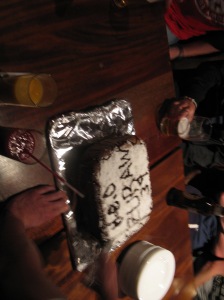
After dinner, myself and Kathryn- an Italian travel agent and amateur runner- went to the club. At the club it was all fun and games. People were ordering drinks and generally chatting. They asked me quite a few things about India like the culture, the food, the weather. I got chatting with Tomasz, who was sitting next to me. He was an amateur runner, and a 2 40 marathoner. He asked me how I started running, and he told me some of his childhood stories, about how he was a really good high school athlete, but then life went in a different direction, and about how a few years ago he restarted running, and now his whole life revolves around it.
After the cake cutting, and singing happy birthday in Polish, i came back to the room, relaxed for a while and went to bed.
Day 13:
Today I got up quite leisurely had breakfast and waited for my 10 am easy run with Joshua. During the run he told me about how he was raised in poverty, and took up athletics as a means of livelihood. He said that being a professional athlete was tough with hard training everyday day, and money being tough to come by. He said that many of the athletes live like this, and that was why they always give 100% at every race.
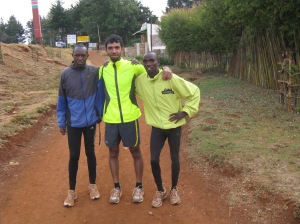
After the easy 50 minute run, I relaxed in the lounge for a while, and had lunch- spaghetti and veges. After lunch I took a short nap, had some tea at 4. The tea they make here has very little flavor, and is different compared to Indian tea. But the athletes seem to love it, having 5 large cups a day. After tea was the core stability class, which was tough as usual. After the class I washed some clothes and had dinner. I said goodbye to the Irish guy who was leaving the next day. He is a very nice guy, always smiling, and with a strong Irish accent which has a nice sing song to it and really nice to hear.
After that I came back to my room, watched ‘the hunger games’ and went to bed.
Day 14:
Today was to be a really tough interval session with Mike- 10*400&5*200. I wanted to reach the track slightly earlier so that I could take some photos of the Kenyans doing their track session. Today there were more runners than last Tuesday. There were two large groups of 25 runners. In my mind, I classified them as- one with Wilson Kipsang and one without. I think they were doing 800s, with around 20s breaks in between.

I took loads of photos and videos- one with Kipsang and one with Paula Radcliffe-, before the Polish gang arrived. Once they did, I did my workout with Mike. We were quite tired after the 400s, but the last two 200s we did with the Kenyans. After that very tiring run, I came back to my room, had a long bath and went for lunch. After lunch I took a long nap, and went to the gym in the evening. Songok suddenly got curious about India, and asks me some words in Hindi.
Then I talked to the guard and learned some words in swahili- habari which means hello.
Asante Sana Kenya (Thank you very much Kenya):
The last two days have gone by very fast. I got a photo of me with Mo Farah, and met the best marathon runner in India, a 19 year old, called Harikesh Maurya. Did a couple of good workouts, and slept a great deal.
Today the polish gang organised a race in the track, a 3000m race. They sponsored the prizes for the first four places, while i sponsored the fifth place. After that I did a 9 km run, then got back to the camp and had some lunch.
As this is the last day i will spend here on this trip, i want to write about how I felt about the experience and about meeting all the different people.
Some of the people I will miss are:
Willy the cook- always asking me if I am ok, discussing football with me, he also supports Chelsea; preparing only veg meals for me, calling me ‘bhin’; asking me about India and the different foods there, says he wants to come there and cook sometime.

Sammy the security guard- always asking me how i am and what i am up to and how my training is going; he has taught me a bit of Swahili and is always eager to teach me more; I meet him every time I come in and out of the camp; he has two kids aged 2 and 4.
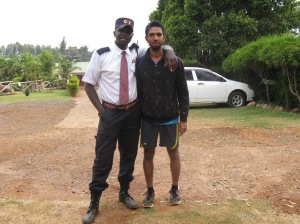
Dane the Australian- very friendly and jovial guy; eager to learn everything he could about running; kept me company in the safari.
Mike the Polish guy- very friendly to me from the moment we met; did around 3 sessions with him and spoke about how he was a vegetarian, an atheist, how he aims to sub 40 for a 10km; works for mystic productions in the music industry; enjoys training and running.
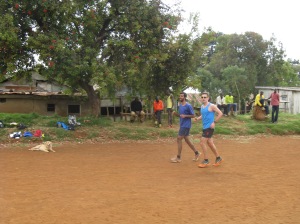
Songok- very friendly and helpful; if there is anything you need, then you ask him; asks me ‘ kaise ho bhai?’, and ‘ is everything ok?’.

Taoufik- very friendly and unassuming; he seems like just another normal person and not like a Olympic champion, which is probably why it took everyone so much time to know that he is a champion; became a good friend and always greets me with a large smile.
Chris the Polish coach- he not only let me join in for their training programs but also invited me to them. Always smiling and is ready to talk and answer questions about running.

The Kenyan athletes- Joshua, James, Ken, Ouin- i have grouped them because they are very similar in both their running and their lifestyle.- they train very hard, running close to 30km each day, run twice a day, run in large groups; they are very friendly and asking about India and the types of races there; they are professional athletes waiting for their big break, which may never come. Always smiling and cheerful, greeting me with a handshake and a half hug.
Katharina the Italian travel agent – she is very friendly and helpful. She came along for the safari, and took most of the photos with me in the picture; a regular lunch buddy of mine.
The Albanian champion 1500m runner Luiza Gega- she does the 1500m in 9 minutes, and is going to run the world indoor next month. I have asked her for water in the middle of the night, for shampoo and for using the internet on her phone; another lunch buddy of mine.
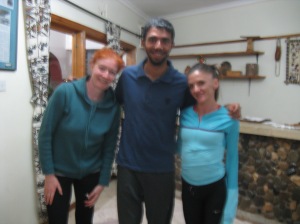
The other Polish guys- they struggle to pronounce my name, so call me anything from abida to abhitomorrow. Very friendly and have included me in most of their activities. All of them are amateurs, here to train and have a good time.
Ian the Irish guy- when he sees me, he asks ‘all right old boy’ in a strong Irish accent. Very good runner and can talk for a long time, always asking lots of questions along the way.
I am going to miss waking up in the morning, having a good breakfast and then going for a ‘Kenyan easy run’. I am going to miss: watching top class athletes do their workouts, the ‘how are you’ shouts of small kids who line the dirt track, the endless dirt trails surrounded by beautiful green fields on either side, the peaceful naps in the afternoon followed by a easy run and killer core workout in the evening, the simple and healthy food, the Kenyan chai, and the sense of excitement before every run.
I ran over 200km in Kenya. I found every run tough and kept thinking that the next one might get easier, but it wasn’t to be. I guess you can’t run like a Kenyan in two and a half weeks; but you can learn and appreciate what makes them so good. I would say genes have a very small part to play. If they had the genes, they wouldn’t have to log 200 km per week for years on end to become fantastic marathoners. I’d say its 95% a combination of: altitude, running on dirt tracks and uneven terrain, running hills on every run, and sheer dedication to the sport. All of them are professional athletes, meaning they have no other job. They run for a living. I think they are such good runners for the same reason that Sherpas are such good mountain climbers; not because of their genes but because of the culture and environment that they have been raised in.
This has been the most exciting, the most productive, and at the same time the most humbling experience of my life. It has made me a friendlier and compassionate person.
The most important lesson I have learned is this: The next time you feel too lazy to go to the gym, or to go for a run, or to do some simple chores, remember that there are a thousand world class athletes in Iten, at 2400m above sea level elevation, doing killer 20km fartlek and interval runs. If they can do that day in and day out, I’m sure that you can get off your backside and get moving!
